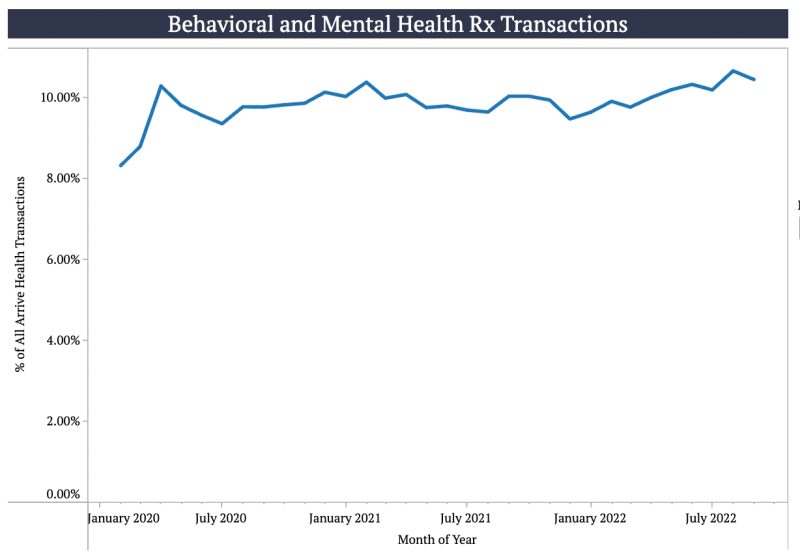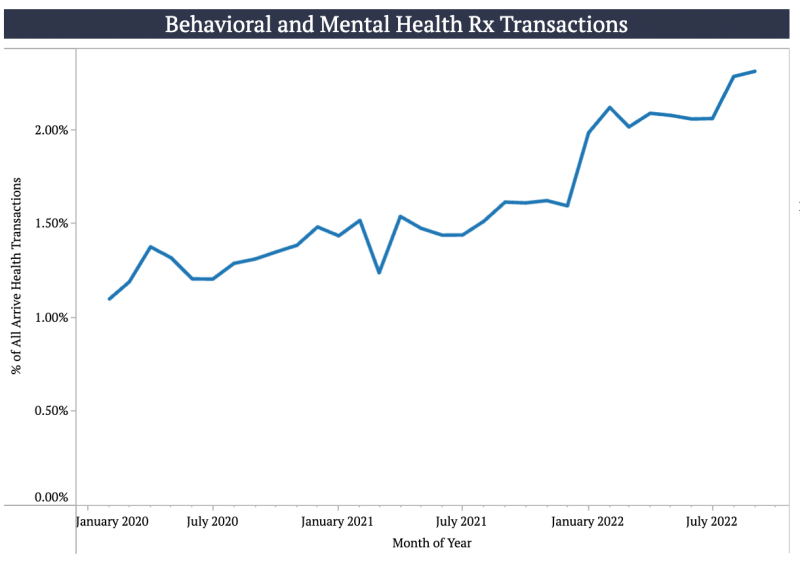Behavioral health medication prescriptions surged early in the pandemic, leveled off and began to rise again more recently, new data shared with Fierce Healthcare show.
Arrive Health is a vendor of real-time prescription benefit services to hospitals and health systems. More than 200,000 providers access the company’s services monthly, with around 7 million prescription transactions occurring a month. To survey pandemic-era behavioral health prescription trends, the company looked at more than 14 million total transactions from February 2020 through September 2022.
The data cover commercial-based and Medicare plan populations and only include prescriptions pending as an order in the EHR—when a physician inputs a medication into the ordering window in their EHR—not necessarily the final medication sent to the pharmacy or confirmation that the patient picked up the medication.
Behavioral health transactions include antianxiety medications, antidepressants, antipsychotics, stimulant therapies for ADHD and sedatives.
Arrive Health data show that following an initial surge in these prescriptions, volumes stayed relatively level for two years, representing between 9.3% and 10.3% of total medication transactions. Since December 2021, however, there has been a slight upward trend in these prescriptions, which reached a peak of 10.6% of total transactions in August 2022.
Previously published data, like from PBM Express Scripts, and national surveys also show a spike in the number of prescriptions written for depression, anxiety and insomnia at the start of COVID-19. Some have explained this consumer behavior as stockpiling medications, in line with early recommendations put out by the Centers for Disease Control and Prevention.
Notably, more U.S. adults report symptoms of anxiety and depression than pre-pandemic. Early on, a greater number of medications to manage them was likely warranted, Megan Holsopple, vice president of clinical products at Arrive Health, told Fierce Healthcare.

All Mental/Behavioral Health Medication Transactions (max volume of 845k/month) (Arrive Health)
“Stress precipitates different reactions in people who have mental health and people who are functioning,” Holsopple said.
“Patients were scared,” echoed Nikki Naples, the company’s clinical content and engagement manager. Naples, a nurse by training, was a nursing and practice administrator at UCHealth in Colorado during the pandemic.
To accommodate patients, providers had to adapt to virtual visits quickly. Restrictions were eased for prescribing medications virtually, and payers lifted the drug quantity limits typically dictating coverage, making access “a little bit friendlier,” according to Holsopple. “The way they got their therapies definitely shifted.” Now, the market is reverting to more standard formulary design, where drug coverage is restricted to certain volumes, she said.
Another reason spikes in prescription volumes appear limited is likely because the populations the data cover have access to additional behavioral support, Holsopple noted. And health systems increasingly recognize the importance of behavioral health specialists and mental health tools. “Just having those resources available now can certainly contribute to why we’re not seeing this large, large spike in medications,” Naples said.
Early 2020 Arrive Health data showed there were notable spikes in prescriptions of chloroquine, hydroxychloroquine and albuterol, ranging from 50% to nearly 125% increases. The likely cause was surging publicity and the presumption they could help manage COVID-19 symptoms.
But in 2021, prescriptions of these therapies drastically decreased, likely as the medical community responded to new evidence. “People do the best that they can with the best intentions,” Holsopple said of providers.
Unlike the other medication categories analyzed, stimulants for ADHD were prescribed in large and escalating quantities over the past two years, Arrive Health data show, with Adderall reaching 2.3% of the company’s total transactions last month. This finding is consistent with other reports of record-high prescriptions and widespread misuse of adderall, driven in part by telehealth companies now being investigated.

Stimulant Medication Transactions for ADHD (max volume of 181k/month) (Arrive Health)
Written by Anastassia Gliadkovskaya for Fierce Healthcare.



